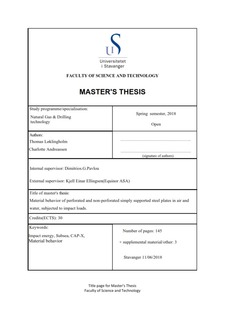| dc.description.abstract | Due to challenging economic times, industries such as oil and gas face the need of moving from customized, time-consuming, and costly solutions, to more standardized technologies, to reduce costs and maintain high profits. In line with this, the Norwegian oil and gas company Statoil (now Equinor) has developed Cap-X, a revolutionary integrated template structure technology for erecting installations on the seabed. However, to enter the market, Cap-X needs to meet the NORSOK standards and requirements, developed by the Norwegian petroleum industry.
This thesis contributes towards such verification, by studying the impact of applied load to the Cap-X technology. It addresses how applied load varies between a perforated plate, such as the surface of Cap-X, and a solid plate, both in water and air, for material within its elastic region. The findings of this study indicate that the perforated plate has a consistent reduction in impact strain, in water and air for the same impact energy. This is perhaps also indicative of NORSOK design criteria being too conservative, as effect of perforations and geometries play important part on strain produced by any given impact energy. However, due to relatively small difference between air and water compared uncertainties in the measurements, this difference cannot be accurately quantified. In addition, as the impact energy being conservatively calculated, that actual difference between strain in water versus air is most likely larger than documented. Based on the results and conclusion made in this paper, further investigation on this topic would be strongly encouraged to accurately determine the reduction in dynamic strain when submerging a perforated plate in water. | nb_NO |

